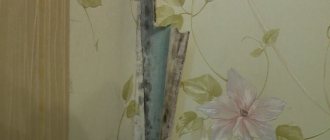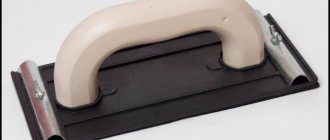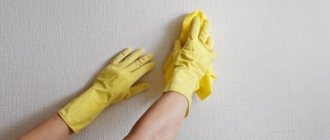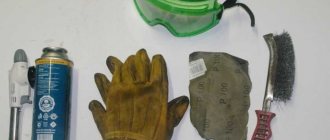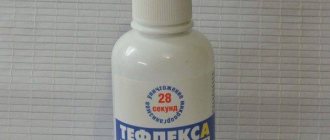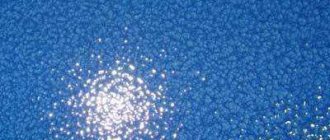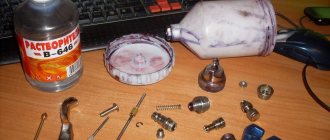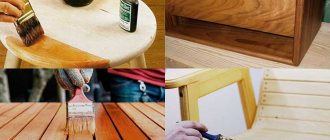Fresh renovations are always nice. Freshly painted walls, furniture, door or window frames look as good as new. But this terrible smell! The intense toxic amber makes it completely impossible to stay indoors for any length of time. It’s great if you have the opportunity to move to another place for a couple of days, but what if you have to stay in an apartment? Today we will talk about how to remove the smell of paint from an apartment quickly and effectively, so that this annoying nuisance does not spoil the first impressions of the updated interior.
photo from the site https://hozinfo.ru/
Fighting paint odor during renovation
The fight against the unpleasant smell of paint in the house must begin at the stage of renovation activities.
Simple preventive actions that will help reduce the intensity of paint odor after renovation:
- Empty the room as much as possible from furniture, belongings and decorative items. Ideally, the room should be completely empty. Fabric materials absorb various odors especially well. Therefore, every effort must be made to remove upholstered furniture. If closets remain, all clothes are removed from them.
- If possible, paint outside or in a technical room. First of all, this applies to removable window frames, interior doors, wooden shelves, etc. All these elements can be removed and taken out into the yard, basement or onto an open balcony.
- Select paintwork materials without a strong odor. Modern industry produces good compositions that are practically odorless. For example, water-based paints do not have a very pronounced aroma, dry faster and are quite cheap. In this case, special solvents (which also have a pungent odor) will not be needed to wash tools after work. There is a special line of materials for painting heating radiators: they contain a minimum of volatile substances.
- Clean and wash working tools outdoors. It is not recommended to flush dirty water from trays down the drain, because... Paint particles deposited on the internal surfaces of pipes will make themselves felt for a long time.
- All textiles that smell of paint (curtains, drapes, clothes) must be washed thoroughly.
- Bring furniture and things into the room only after the air is completely fresh.
- Open windows while painting. This will allow most of the harmful fumes to escape outside. There is no need to create a draft, because This is fraught with illness for workers.
- Follow the rules for storing paint and tools. The jars with the remaining composition must be tightly closed (samples that are too smelly are additionally placed in an airtight bag). For storage, it is better to choose a place outside the home. This could be a basement, garage or shed. The same applies to painting tools - rollers, brushes and sponges. They need to be thoroughly washed, dried and placed in an airtight container.
Before painting indoors
From the aroma of paint remaining after painting work indoors, a person experiences a feeling of irritation, discomfort and even headaches and dizziness. In addition, if the paint in the house stinks, it is harmful to the health of the residents, therefore, it is better to get rid of the nasty aroma quickly.
As a rule, to paint objects in a residential area, you must first select the paint that contains a minimum of harmful components and does not stink so much.
You can currently find suitable paint for interior finishing work in any construction market, but when the moment has already passed, going to the market will be useless, and you will have to deal with the consequences of haste, economy, and thoughtlessness.
So, for example, even before painting begins, it is necessary to cover with newspapers or rags all adjacent objects on which paint may get or drip. The less nasty odors remain in the room, the easier it will be to solve your problem.
When performing painting work indoors, you should also keep in mind your own safety by ensuring ventilation and protection of the respiratory tract, for example, using a cotton-gauze bandage.
The smell of paint is not only unpleasant, but also harmful, which means you need to show all responsibility and caution before starting work (how to paint wallpaper)
Ventilation
The primary and simplest measure to combat paint odor after renovation. The warm season is suitable for its implementation (therefore, it is better not to do repairs in winter). Its effectiveness directly depends on the intensity of ventilation. Ideally, this should be a draft, for which all windows and doors in the apartment are opened. You can turn on the fan.
The duration of this procedure is at least 24 hours. It is better to foresee this aspect in advance and plan a trip with the whole family to the dacha or to relatives at this time. If this happens in winter, then it is advisable to turn on the supply ventilation to maximum and try to increase the temperature in the room (within reasonable limits). This will increase the rate of evaporation of volatile aromatic substances from the finished surface. Humidity is reduced as much as possible.
Fast and effective ways
After the renovation is completed, a nasty smell of paint always remains in the room, and if you don’t get rid of it, bad consequences for the body are possible.
Emergency methods will be listed below, and each of the proposed methods can be used both in a personal home and in an apartment.
Effective ways:
- Ventilation of the room. This is an old and time-tested method that does not lose its relevance even today, when the most constructive measures have already been invented. It will be quite easy to weather the paint if you open all the windows, and in a private house also the doors. A couple of days will be enough for ventilation. During this time, it is worth moving to another place, since drafts are no less unsafe for health.
- Buckets of water. Water is a good sorbent. It will help reduce paint odor and absorb toxic fumes. To do this, you should place buckets or huge pots with clean water in the room where the repair was made and leave it for 3-4 days. The water must be renewed once a day.
- Air conditioner. For this method, only those models of air conditioners that are equipped with an air purification function are suitable. It is recommended to use this method in cases where ventilation for any reason is unrealistic.
- Wet sheets. This is the method of our great-grandmothers. You should take sheets or large towels, wet them and hang all protruding surfaces (chairs, doors, cabinets). As they dry, rinse again under running water.
- Humidifier. This is a modern method that is used in rooms without windows (when ventilation is impossible). It works and will help you cope with this problem after painting. It will be necessary to wipe the floor a couple of times a day, since the vapors from the humidifier, coupled with the paint and varnish composition, will fall down.
It is worth realizing that until the paint is completely dry, the evaporation of particles will continue. Only open windows can ensure better air circulation.
Wet cleaning of painted surfaces
Wet cleaning of painted substrates helps to quickly get rid of odor. However, if you use plain water, the effect will be negligible.
The following additives are used to prepare aqueous solutions:
- Dry mustard. Add 1-2 tablespoons of the substance into a 10 liter bucket of warm water. Having crushed the liquid, wipe the painted bases with it (it is more convenient to do this with a sponge). As a rule, this option is used for processing wooden surfaces.
- Vinegar or ammonia. The concentration here is slightly less - 1 tbsp. l./5 l of cold water. The prepared solution can be used for wiping wood, metal and plastic substrates.
Basic methods for eliminating paint odor
Unfortunately, household air fresheners are not suitable for getting rid of chemical fumes in a room after renovation: they do not completely eliminate the strong smell of oil paint. In such a situation, it is advisable to take other measures:
- organize a draft in the home to ventilate toxic fumes, that is, ventilate well;
- carry out general cleaning, wipe the floor and interior parts with water with the addition of absorbent substances;
- place open basins or other large containers with water in the rooms, hang wet towels;
- use air washers or ozonizers;
- apply absorbents;
- overpower the amber with a more persistent aroma using substances that are safe for health.
With these steps, we are guaranteed to get rid of the unpleasant smell in the apartment at home.
Good to know! The evaporation of paint and varnish materials during repairs will be significantly less if you keep the windows open during painting, clean brushes and tools outdoors, and use modern surface coating products (for example, those made on a water-based emulsion).
Removing odor with conditioner
Modern air conditioners have a function that allows you to get rid of the stench without disturbing the comfort of the apartment residents. We are talking about the “air purification” or “ionization” modes (this nuance must be clarified when purchasing the system).
A prerequisite for devices of this type is indoor air intake. When air enters the air conditioner, it passes through a series of special filters. This allows you to extract small solid particles, dust and volatile toxins that are part of the paintwork material from the flow. At the second stage, the air enters a special chamber, where it is enriched with negative ions. Cleaned portions are returned to the premises.
Technical devices
Residents of apartment buildings often resort to folk methods to get rid of the smell of oil paint and enamel after renovation.
Technical devices will come to the rescue:
- Air conditioner. Modern air conditioners are equipped with an air purification function that will remove stench and suspended particles in the air.
- Humidifier. Humidity does an excellent job of this task, and with the help of modern humidifiers you can not only clean the air, but also aromatize it. This method is not fast, but it is undoubtedly effective and safe.
- Ionizer. This device not only solves the problem, but also purifies the air from bacteria.
- Hood. An ordinary hood, which is most often installed in the kitchen, can also help cope with this problem.
The use of technical devices requires financial costs, but you will be confident in the safety of such methods and will be able to save your time.
Using Air Purifiers
These devices were specially designed for areas with high levels of air pollution. They are often used to combat unpleasant odors. Not every type of device will help get rid of the stench of paint.
To help you select the right air purifier model, the following table is provided:
| Name | Operating principle | Degree of effectiveness in combating paint odor |
| Mechanical | A fine mesh made of polymer or steel is used as a filter. An option with rough fabric and foam rubber is possible. Filters trap large dust and animal hair. The advantage of the devices is that the filters are reusable. To remove accumulated debris, they are washed or vacuumed. | Low |
| Adsorption | The operation of the devices is based on the properties of activated carbon to absorb various toxins. This does not apply to formaldehyde and carbon monoxide. It is important to take into account the fact that as the filter operates, it accumulates harmful substances, so it must be changed periodically. | Average |
| Electrostatic | They successfully purify the air from particles measuring about 0.01 microns. They work using plates with a negative charge. Before this, the air is passed through an ionization chamber, where all impurities are given a positive charge. Cleaning the filters is very simple and involves washing with soapy water. | good |
| NERA | The devices got their name from the type of filters used. HEPA purifiers are presented in 5 classes according to the degree of air purification. Capable of capturing pollen, asbestos and cement dust, various odors and even bacteria. | good |
| Photocatalytic | They function thanks to innovative technology - photocatalysis. It is based on ultraviolet radiation, under the influence of which organic impurities break down into harmless components. | Good (only for organic based materials) |
Inexpensive and practical carbon cleaners are most often used to combat paint odors. When purchasing, it is advisable to choose models with ionization and ozonation functions. In addition, there are specialized companies that provide air purification services. For this purpose, professional equipment is used that generates “dry fog”. The artificial atmosphere created in the house neutralizes volatile toxic substances within a short period of time.
Fight or be patient?
At first glance, it may seem that this is not a very significant inconvenience, and after a short time you can sniff it and stop noticing the stench, or simply wait until it disappears, without fooling yourself about how to remove the smell of paint from the apartment. This point of view is very dangerous, because the smell of paint is not only, and not so much a banal inconvenience. This is also a direct threat to health, especially if there are children or thin women in the house, for whose small mass the dangerous concentration of toxic substances is quite low.
Acute intoxication with paint vapors is not so rare in medical practice, and is manifested by the following symptoms:
- Intense headache that gets worse over time;
- Redness and itching of the mucous membrane of the eyes, lacrimation;
- Dizziness, possible confusion;
- Unpleasant taste in the mouth, nausea and vomiting that does not bring relief;
- Frequent loose stools;
- A faint and later distinct odor of acetone from the mouth.
As you can see, the manifestations are nonspecific and can easily be mistaken for ordinary food poisoning or an intestinal infection. Do not ignore the first symptoms, especially in children; if a child remains indoors, they can get seriously poisoned, disrupting the functioning of the respiratory center. In addition, do not forget about possible allergic reactions in the form of skin rashes or suffocation, as well as exacerbation of bronchial asthma.
photo from the site https://otravleniy.net/
Know how to help!
At the first signs of poisoning, you should immediately leave the apartment, ensure free breathing by removing tight clothes or unfastening your belt or collar. Drink plenty of alkaline mineral water, and try to lie down. Rinse eyes with plenty of water.
Getting rid of odor with water
Purchasing an air purifier for use exclusively after repair is not always practical. You can go the cheaper route. For example, ordinary water has good absorption characteristics. With its help, you can effectively refresh a room in 1-2 days.
The procedure is very simple:
- Take several large pieces of thick fabric. Thick terry towels and robes work well. If they are unavailable, you can use cotton sheets and tablecloths.
- After soaking them in running water, hang them in a wrung out state in a room where you can smell the paint.
- From time to time, the damp cloth should be removed and rinsed. This makes it possible to get rid of toxins that accumulate on its surface.
- After rinsing, the material is hung again. The procedure continues until the stench disappears completely. It is very important to keep the fabric damp all this time, because... As it dries, the aromatic substances will evaporate.
In addition, water can simply be collected in large containers and placed in the room where the painting work was carried out. Buckets, basins, etc. are suitable for this. They are usually placed in the middle of the room. To enhance the effect, add a piece of lemon and 40 g of salt to each container. White vinegar is suitable instead of lemon and salt. It is added at the rate of 200 ml/10 l of water. Upon completion of the procedure, the water must be poured out, because... it is not safe to use.
Tips and prohibitions
To achieve the desired result, it is important to listen to a number of professional comments:
- When preparing an aqueous solution, it is unacceptable to simultaneously add mustard with vinegar or ammonia, which will lead to an undesirable reaction (use these components separately).
- Coffee will only kill the unpleasant aroma, but will not protect residents from harmful chemical fumes.
- Laying out onions and garlic for a long time can lead to the fact that all uncovered furniture and clothing are saturated with their smell.
- The ionizer and ozonizer can be turned on simultaneously.
- Do not pour water used for cleaning down the drain (paint particles may settle on the pipes and continue to emit a toxic odor).
The paint and varnish industry does not stand still, so now there is a fairly extensive range of products without pronounced aromatization. Therefore, it is recommended to choose it. And for batteries there are special compounds that do not appear even when heated.
It is equally important to follow the rules for storing paint and varnish products and brushes after intended use . It is advisable to keep them in non-residential premises (pantry, basement).
If these are not available, the jars should be closed as tightly as possible, and additionally packed in plastic and placed in well-ventilated places (for example, in a bathroom or toilet).
Rollers, brushes and other tools are also stored in film bags.
In order to quickly and better clean the air in the room after renovation, do not be afraid to resort to several methods at the same time .
So, along with ventilation, you can place buckets of water everywhere and lay out napkins soaked in essential oils. Then the result will be noticeable in a few hours.
Getting rid of odor with onions
This crop has a natural tendency to absorb unpleasant odors. White and yellow varieties of onions purify the air best.
Operating procedure:
- Large and medium-sized bulbs are freed from the outer peel and cut into even halves with a knife.
- A separate plate or any other stand is prepared for each of the halves. In large rooms their number can be doubled or tripled. The cut part of the onion should face up.
- The opposite walls of the room are chosen as the points for placing the bowls. The onion is left until the air is completely purified (sometimes one night is enough for this).
- Upon completion of the procedure, the contents of the plates are thrown into the trash. It is unsafe to eat due to the absorbed toxins.
How to prevent unpleasant odors
So how do you get rid of paint smell? Before the problem arises, you can take some preventive measures. There are a number of rules that, if followed, will prevent the appearance of an unpleasant odor:
- You should choose the right paint. PF enamel should have no pungent odor.
- Painting work should be carried out with the windows open.
- It is recommended to wash off remaining enamel from instruments in the fresh air.
- Proper storage of paint cans, as well as brushes and rollers will help prevent unpleasant odors.
Using charcoal and coffee beans
These substances also have good sorbing characteristics.
You need to do this:
- Grind the material. When working with charcoal, you can operate manually (just wear work gloves). A coffee grinder is usually used to grind coffee beans. The grind level should be coarse.
- Pour the prepared sorbent into bowls in a thin layer. For larger spaces, you can use dishes or trays. Stands with material are evenly placed on the floor or stools.
- The duration of the procedure is until the air is completely purified. This usually takes at least 12 hours. The door to the room must be tightly closed.
- After finishing cleaning, the contents of the trays are poured into bags and taken to the trash.
How to remove an unpleasant odor from a room after renovating or painting the floor?
It is not possible to eliminate strong chemical fumes in a room using conventional air fresheners. This will require more effective measures that are easy to implement.
Ventilation
The first thing that comes to mind is long-term ventilation . To do this, open all windows and doors for a day or longer, depending on the situation.
Additionally, it is recommended to turn on the fan (in case of calm weather), which will increase the movement of air masses and reduce humidity. Then the smell from water-based enamel will disappear within a day, while solvent-based enamel will take a little longer.
This is one of the most effective methods, but it causes a number of inconveniences for residents - they need to move to another place for this time.
Air conditioner
If the living space is equipped with modern air conditioners, then you can quickly restore a comfortable microclimate with their help.
The main thing is that the split system has the functions of “air purification” or “ionization”. Then the air is first driven through filters and cleaned of dust and toxic impurities, then saturated with ions.
Conventional models of air conditioners only reduce the humidity in the room, which negatively affects human mucous membranes and can cause serious complications.
Pure water or in the form of a solution
This option is no less effective, since water absorbs odors well. It is necessary to place containers with water where painting was carried out .
Just change it for a fresh one at least once every 2-3 hours. To get rid of oil paint fumes, it is recommended to add table salt to the water.
An alternative to basins is a household humidifier. Before turning it on, close the windows and doors tightly. When exposed to moisture, the chemicals will settle down, after which all surfaces should be wiped with a damp cloth.
You can add one of the following to the water:
- mustard powder (1 tbsp per 5 liters of water);
- ammonia or vinegar (ratio 1:5);
- vanilla extract or mint ether (4-5 drops per five-liter bucket).
If such a device is not available and there is no desire to tinker with containers, since the living area is too large, then you can wet fabrics (terry towels, sheets) and hang them everywhere. They are rinsed periodically. Continue the procedure until the air is completely purified.
Vinegar
Vinegar essence perfectly neutralizes unpleasant odors . The simplest thing you can do is soak a rag in it and wipe everything in the room. However, this option is not suitable for painted surfaces.
If the smell of paint is extremely persistent, it is recommended to pour pure vinegar into containers and place it around the perimeter of the living room. If the amber is not so strong, then it will be enough to dilute it with water in a ratio of 1:5.
During cleansing, you should leave the room to avoid poisoning from vinegar fumes. Upon return, open the windows briefly for ventilation.
Onion and garlic, lemon
If the renovation took place in winter and the weather does not allow opening the windows for a long period, they resort to other options for eliminating the heavy odor. You can chop the onion and, together with the garlic, put it in containers and place it around the apartment .
But due to the fact that they emit a specific smell, they do not remain for a long time. Otherwise, he will be absorbed into the situation.
After the room is completely cleaned, the vegetables are immediately thrown away. Then the onion-garlic amber will quickly eliminate itself.
Another quite productive way is to place lemon (orange, tangerine) slices everywhere for a couple of days . Used citrus is thrown away. This will not only eliminate paint odor, but also freshen the air.
Aroma candles
If you have aromatic candles (although regular ones will do), they will successfully cope with the task. They are placed in rooms that have undergone renovation and set on fire. Leave to burn for at least 2 hours. As a result, the heavy odor will evaporate.
While candles are burning, they must be constantly checked to prevent a fire. And also do not place them next to curtains, paper and other flammable objects.
Sorbents
Do not forget about substances that can be combined into one group called sorbents.
These include:
- soda;
- coffee beans (ground);
- charcoal;
- silica gel;
- salt.
You don't need to do anything with them. They are simply poured into small containers and placed around the premises. These products should be renewed 1-2 times a day, and used ones should be thrown away.
Since absorbents absorb not only toxic particles from the air, but also moisture, additional humidification should be provided . You can use a steam generator. If it is not there, then pour water into a large saucepan and place it on low heat. While the heating radiators are operating, cups of water are placed on them or damp towels are thrown over them.
Coffee can be pre-brewed and used in the same way. To do this, place cups with a strong and aromatic drink. In just a few hours the irritating odor disappears. This alone will not help remove harmful chemical fumes.
Baking soda is great for removing odors from furniture upholstery and carpets . You need to scatter it over the surface and leave it overnight, and go through it with a vacuum cleaner in the morning.
Aroma oils
Aromatic oils will not be able to reduce the concentration of harmful particles in the air, but they can mask them until they disappear completely. This method is acceptable only for minor paint fumes.
To give the air a more pleasant aroma, soak cotton wool or ordinary cosmetic discs in any essential oil and place them near painted objects. Peppermint and vanilla esters work best at masking heavy amber.
Using an open flame
Volatile toxic substances are neutralized by direct contact with open fire. If possible, turn on a gas burner in the room for a short time (like those used when installing PVC stretch ceilings). It is clear that such a radical method will not work everywhere.
You can also use regular candles, evenly placing them on safe stands. Such cleaning may only be carried out under constant supervision. A safer option is to “work out” the room with a simple “wind blower” heater. The air in such devices is forced through a hot metal sieve, where the toxins will “burn off.”
How to choose paint
PF paint is considered the most popular coating. The range of such material is quite large. This allows you to choose not only the appropriate color, but also the consistency. It is worth considering that water-based paint has a less pronounced aroma. It dries within 2-4 hours. As for the cost of such products, it is very affordable. To remove remnants of such paint from tools, the use of special solvents is not required.

